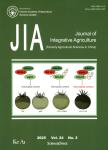Construction of a New Molecular Barcode for Discriminating Plants and Animals with a Close Genetic Relationship
Construction of a New Molecular Barcode for Discriminating Plants and Animals with a Close Genetic Relationship作者机构:Laboratory of Cell & Molecular Biology Institute of Vegetable Science Zhejiang University Key Laboratory of Horticultural Plant Growth Development and Quality Improvement Ministry of Agriculture College of Life and Environment Sciences Hangzhou Normal University College of Animal Science Zhejiang University
出 版 物:《Journal of Integrative Agriculture》 (农业科学学报(英文版))
年 卷 期:2013年第12卷第7期
页 面:1138-1151页
核心收录:
学科分类:0710[理学-生物学] 071001[理学-植物学] 07[理学] 071002[理学-动物学]
基 金:supported by the Key Sci-Technology Project of Zhejiang Province (2010C12004) the Sci-Technology Project of Zhejiang Province (2009C32026) the Sci-Technology Project of Jiaxing City, Zhejiang, China-(2010AZ1004)
主 题:molecular barcode molecular marker Cruciferae Sus F-AFLP
摘 要:DNA barcodes have been proposed as a shortcut to provide species identification and as a way to accelerate the discovery of new species. A number of candidate gene regions have been suggested as possible barcodes for animals and plants, but for the identification of recently diverged species and/or varieties with only a few genetic differences it has been reported to be problematic in some cases. This study selected widely cultivated cruciferous vegetables as the primary samples, after failure of discrimination of each species using current DNA barcodes, we performed the fluorescent amplified fragment length polymorphism (F-AFLP) and successfully discriminated each species, subspecies, variety and their cultivar in 74 samples. Then the non-qualitative results obtained from F-AFLP were transformed into two-dimensional barcodes image file of each cultivar via the PDF417 software. This method was also successfully applied to the discrimination of 17 Chinese indigenous pig breeds. The barcode we constructed which greatly reduces the information storage space is genotypes-specific, and can be conveniently decoded into the original data and thereby be conveniently shared and referred to. We believe that it is possible to construct a new data sharing molecular barcode system that could discriminate the subspecies, varieties, cultivars and even individuals with close genetic relationships.




